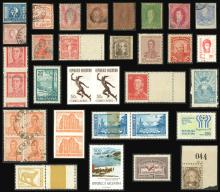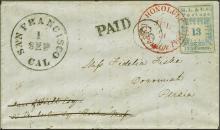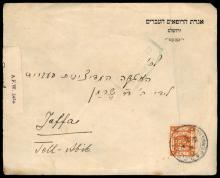Philatelic Fakes Stamps and Forgeries
Published

The making of Fakes and Forgeries is an activity that has been in existence since the early years of philately. It is done in order to defraud or deceive others in assuming that those forgeries and fakes are the authentic items. In the study of stamps known as Philately, this activity is very common thus learning to identify the authenticity of stamps from the fake is considered an interesting and important challenge.
Definition of Terms:
To best understand this article, definition of terms related to the study are:
- Forgery is the word used to refer to those stamps that are produced to defraud collectors (or accurately known to be forgeries) and the government issuing these stamps (accurately branded as counterfeits)
- Fakes is a word used to designate alterations of certain genuine stamps to make it look real. These are those cancels, added perforations, clipped perforations, alterations in the stamp designs and overprints.
The definitions above follow the introduction of the “Scott Standard Postage Catalogue” in its latest editions. Though certain philatelists strictly follow specific definitions this may not be the case for every writer.
When can stamps be considered for legitimate production?
There are many questions that are being raised as to when stamps are produced for purposes of postage. International recognition of stamps that were produced makes them legitimate even though they are not recognized through specific international agreements behind its production. This similarly follows with the principle through which the international law applies its recognition of nations or states. As in this case of a nation or state, both are recognized if they are treated as such by the international community. One example is the Karabagh, which is not a UPU member. Mails from them are still delivered and these stamps were not considered as propaganda labels or something that involves money-making scams.
When did the production of stamp fakes and forgeries begin?
It was believed that fakes and forgeries of stamps took place sometime before the year 1863, since it was in 1863 that the book “Forged Stamps: How to Detect them” was published. By 1864 forgeries were being produced in many places around the world, such as Austria, Guiana, Spain, British, Finland and India.
Among the master’s forgers in the field of philately is Jean de Sperati. His forgeries were masterly produced by bleaching a real stamp that is cheaper in price compared to a vintage one then through photolithography he was able to process this into an impeccable copy. He was able to forge around 550 copies in his lifetime and his work has been identified through some pencil markings at the back as he has signed some of them. As a result, most of his works were considered of higher value than the authentic stamps he copied.
W hat makes postal stamps as the ideal target for counterfeits and forgeries?
hat makes postal stamps as the ideal target for counterfeits and forgeries?
The production of counterfeits is more appealing to some groups since the stamps they manufacture is intended to be in bulk to cover for the production expense incurred. Since it is sold at a much lower price, the buyer will find it better to purchase these counterfeits in an assumption that they can save money from the purchase and use. With that, the most commonly used stamp is the ideal target for counterfeit production.
The stamp known as the Black Penny was considered as the first targeted stamp that was copied in the year 1840 after its first year of production. The processes conducted in the forgery were the change in color and in the change of some numbers to follow those stamps that were expensive in value. Other forgery methods were done with the erasure of markers and the placing of another stamp on top of it. Due to these forgeries, the Spanish Post began to change their stamps every year between 1850 until 1879 in order to stay ahead of the forgers.
Postal measures to counteract against forgeries in stamps
Since the integrity of stamps was questioned, most post offices established certain counter-measures. These included the use of watermarks, special set of paper, intricate engraving and special printing processes. Likewise, there were distinct inks that were used for the postal marks as well as the use of silk threads inserted in between the paper layers. Another measure was the use of secret codes which are not visible to the naked eye or a microscope, but only visible through the use of special lighting. The re-issuing of stamps was also initiated as another measure to counteract forgeries.
Philatelic forgery identification using cancellation marks
It is very hard to distinguish between postal or philatelic forgeries if the stamps are unused since the production process is basically the same. However, bearing a cancellation mark makes it easier to distinguish. Forgery made in the cancellation marks of stamps were done with the intention of selling these to stamp collectors and not for mailing purposes. Still there were some forgeries that used the authentic cancellation process like using these forged stamps in their mails, a process that was practiced with great care. The scarcity of counterfiets reaching the philatelic community makes them valuable, which initself is an incentive for the forger.
Books about Philatelic forgeries
Among the most known books in the topic of forgeries of stamps were the “Belgium De la falsifications des timbres-poste“ which was authored by Jean-Baptiste Moens in 1862. The next book was that written by Robert Brisco Earée is “Forged Stamps: How to detect them”. The books of Serrane entitled Vade Mecum and Album Weeds of Earee were those that tackled the subject about stamp forgeries.
Why forged and fake stamps were in demand
Stamp collecting became popular in the 19th century and for those that need certain stamps that are already unavailable, they took reproductions to cover those empty spaces in their albums. These reproductions became so rampant since it was used in the packet trade. Because of this, there was no guarantee that even those common stamps were not being forged.
What are fakes in stamps?
Stamp fakes use genuine stamps with certain alterations made on them in order to make them more valuable for stamp collectors. When catalogues present a particular stamp that shows varieties in value, it becomes very tempting to alter the cheaper samples into a stamp that can be sold at a higher price giving bigger profit to an individual. Even minor variations in the stamps can already affect its value.
It is important to have the knowledge in detecting the most obvious forgeries and fakes, knowledge that can help you save on expertise and evaluations. However, even this knowledge is not always an effective means of establishing a certain stamp as a fake or forgery or even as a genuine. The process involved there is more complicated and should be discussed separately.








